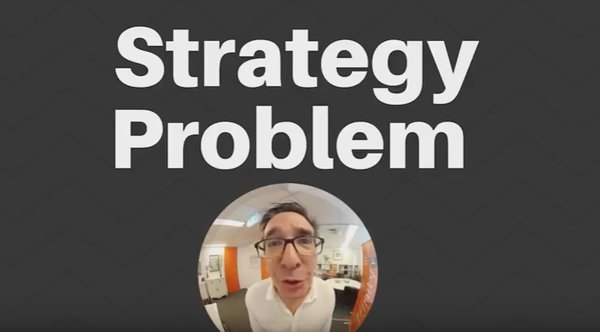This is the fifth in a series of one minute videos that address one of the many complex challenges facing marketing, media and advertising today. The Golden Minute series is an attempt to prove Albert Einstein right when he said “The definition of genius is taking the complex and making it simple”.
But he also said “Everything should be made as simple as possible, but not simpler”. So we will leave it for you to judge. Please let us know here if there is a topic you would like us to cover in a Golden Minute.
As we have shared previously, much of the work we do with our clients is to align their structure and process to effectively deliver their marketing strategy. The starting point in this process is reviewing the agreed strategy so we can determine the requirements of that strategy that need to be delivered to achieve the results or objectives.
But with all of the complexity in marketing these days and the diversity of business objectives, especially in larger organisations, that are supported by marketing, we often find there is more than one strategy and often multiple strategies that are misaligned or even worse, in conflict with each other.
With marketing strategies, communications strategies, channel strategies, digital strategies, media strategies, and more, is it any wonder achieving alignment across these is so hard?
Aligning digital strategy to marketing
Digital technology and digital marketing has been particularly disruptive inside many organisations, to the point that it became common to have a digital marketing arm within the marketing structure.
These were populated with digital specialists to work beside the marketing team. The problem was that instead of integrating digital into the marketing mix, it often became a separate channel or work stream from marketing, working across more parts of the business than the marketing team.
For one marketing team we were engaged by, it had developed to the stage where the marketing team and the digital team were working to separate strategies and in fact often working at cross purposes to the overall strategy.
The reason, we determined, was that the digital team had better integrated themselves with areas such as sales, retail and finance to the point they were taking and developing strategy to deliver the needs of these areas and undermining the role of marketing.
Aligning media strategy to marketing
With all of the controversy over media transparency, you would think that the media strategy would be aligned to the overall marketing objective. But it appears that with the complexity and confusion many marketers have over digital media and the programmatic buying of this media, there is often a misalignment of objective and strategy.
We have seen this recently with major brands compromised over brand safety because the programmatic media buy has been compromised for achieving lower costs.
We were engaged to assess the performance and value of their media investment, particularly with a focus on their digital media investment, which had increased over the previous few years to be more than 30% of the total media investment.
The marketing strategy was to increase awareness amongst the target audience and trial, while the media strategy was simply to increase awareness at the lowest cost per thousand. It appears that the increase in digital media investment was due to the effective lower cost per thousand and not for the opportunity of encouraging and measuring trial.
Aligning sponsorship to marketing
Sponsorship can be a contentious investment, often part of corporate affairs, marketing and even sales, yet the budget often resides with marketing. The interesting part is that many times sponsorships are taken on by organisations for reasons beyond the marketing strategy and yet if paid from the marketing budget it is considered part of the marketing spend.
At the same time the performance measurements for sponsorship can be highly subjective or even non-existent.
The Head of Marketing was under pressure to make cuts to the marketing budget and yet the sizeable sponsorship budget was considered off limits. We were engaged to assist with the review of the marketing budget by the Marketing Lead and we applied a Zero Based Budgeting (ZBB) approach to the entire marketing communications budget, including the sponsorship budget.
Quite a significant portion of the budget was to support sales with event sponsorship. Investigations with sales revealed many of these were legacy sponsorships with little or no demonstrable return on investment. Likewise there were several large corporate sponsorships that had originated from board recommendation. The result was a 15% cut in the marketing communications budget, almost entirely from the sponsorship budget.
Aligning marketing strategy to the business
Ultimately with so many different strategies being executed, in most marketing teams, it is a challenge ensuring alignment even to the marketing strategy. Social media strategies, digital strategies, media strategies, shopper strategies, mobile strategies, communications strategies, channel strategies, the list can be endless.
While many will say that the number of strategies is simply a reflection of the complexity of the marketing requirements, the fact is that this multiplication of strategic initiatives can be indicative of a lack of alignment.
We often find that rather than developing separate strategies, it is best if there is an overarching brand or marketing strategy, that is aligned to the business requirements, and then the various channels are an extension of this strategy.
In fact the overall or master strategy should define within it the channels to be used rather than having multiple strategies being developed for various channels. This ensures greater alignment to the marketing strategy and the business objectives and means there is a consistency of approach across the marketing function and the organisation.
Golden Minute Script
Do you have a marketing strategy?
What about a digital strategy?
A social media strategy?
A channel strategy?
How about a comms strategy?
How many strategies do you have?
Today there is a strategy for everything and a strategist for everything
And they are often not aligned
So everyone ends up working against each other
Great strategy is a reductive process
It is as much about what you don’t do as what you do
After all, you can do anything
But great strategy focuses your limited resources to achieve your objectives.
So next time someone offers you another strategy,
Ask yourself does it further your strategy or just add to the confusion?
Read more on ways we can help you align your marketing strategy to the business objectives or independently assess your marketing strategy against performance.




